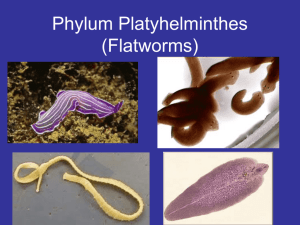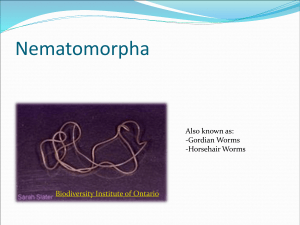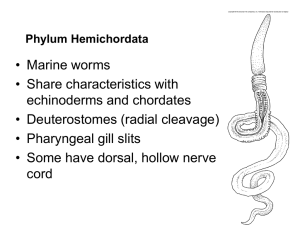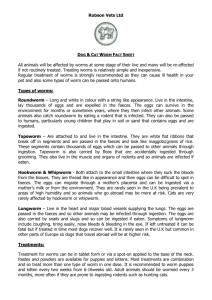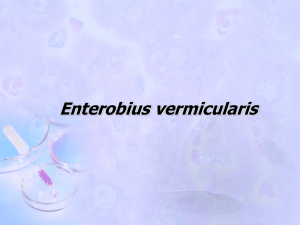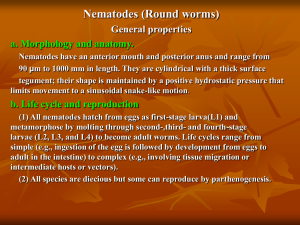Chapter 18 Supplement
advertisement
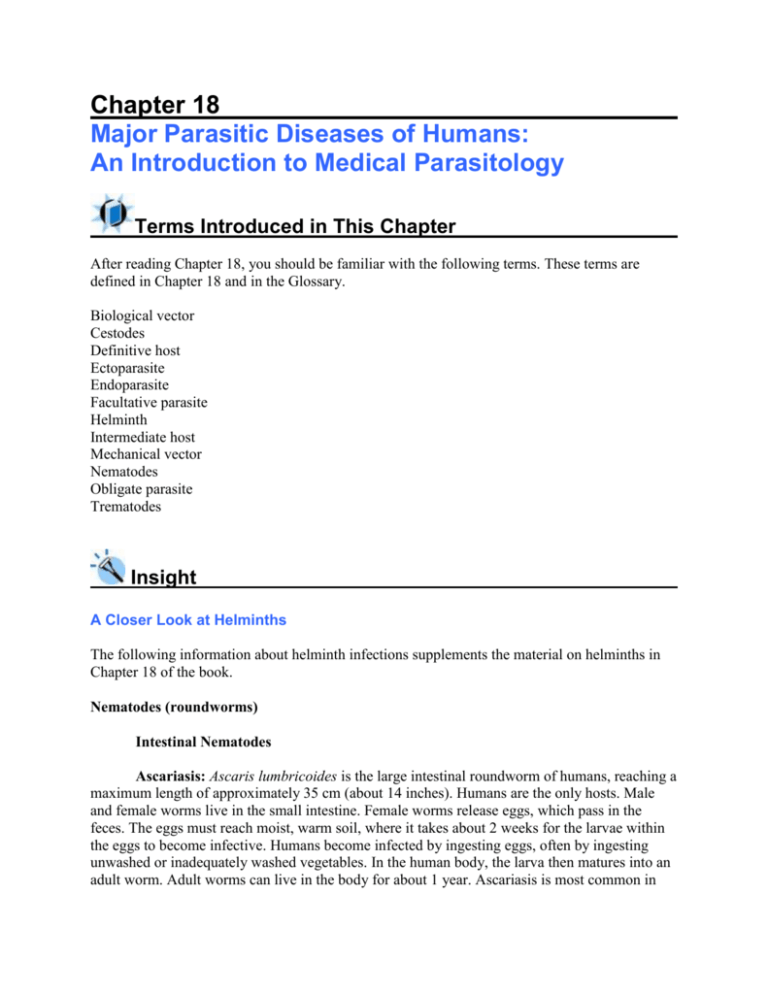
Chapter 18 Major Parasitic Diseases of Humans: An Introduction to Medical Parasitology Terms Introduced in This Chapter After reading Chapter 18, you should be familiar with the following terms. These terms are defined in Chapter 18 and in the Glossary. Biological vector Cestodes Definitive host Ectoparasite Endoparasite Facultative parasite Helminth Intermediate host Mechanical vector Nematodes Obligate parasite Trematodes Insight A Closer Look at Helminths The following information about helminth infections supplements the material on helminths in Chapter 18 of the book. Nematodes (roundworms) Intestinal Nematodes Ascariasis: Ascaris lumbricoides is the large intestinal roundworm of humans, reaching a maximum length of approximately 35 cm (about 14 inches). Humans are the only hosts. Male and female worms live in the small intestine. Female worms release eggs, which pass in the feces. The eggs must reach moist, warm soil, where it takes about 2 weeks for the larvae within the eggs to become infective. Humans become infected by ingesting eggs, often by ingesting unwashed or inadequately washed vegetables. In the human body, the larva then matures into an adult worm. Adult worms can live in the body for about 1 year. Ascariasis is most common in areas where human feces (“night soil”) is used to fertilize crops. Pinworm infection: Enterobius vermicularis (pinworm) infection is the most common helminth infection in the world. Humans are the only hosts. Male and female worms, which reach a maximum length of about 13 mm, live in the cecum (the first part of the colon). Female worms migrate down through the colon, emerge from the anus, and release eggs onto the perianal skin. The eggs are fully embryonated and infective within a few hours. Humans become infected by ingesting the eggs. In the human body, the larva then matures into an adult worm. Adult worms can live in the body for several months to several years. Hookworm infection: Necator americanus (the new world hookworm) lives in the small intestine, where it anchors itself to the intestinal mucosa by means of its well-developed mouth parts (called cutting plates). Female worms release eggs, which pass in the feces. The eggs must reach moist, shady, warm soil, where they hatch within 1 to 2 days. In the soil, it takes about 5 to 8 days for the immature larva to become a mature infective larva. The infective larvae remain viable in the soil for several weeks. Humans become infected by penetration of the skin (usually the soles of the feet) by the infective larvae. In the human body, the larva then matures into an adult worm. Adult worms can live in the body for 4 to 20 years. Humans are the only hosts. Tissue Nematode Dracunculiasis: The adult Dracunculus medinensis (guinea worm), which can be up to a meter in length, migrates in the deep connective tissues and subcutaneous tissues of the body. The female worm migrates to the ankle or foot (usually), where a blister forms. On contact with water, the blister bursts, and a portion of the worm protrudes through the opening. Larvae are discharged into the water. A larva is ingested by a small, freshwater crustacean called a Cyclops. Within the Cyclops, it takes about 8 days before the larva becomes infective for humans. Humans become infected by drinking water that contains the infected Cyclops. In the human body, the larva matures into an adult worm. In this life cycle, the human is the definitive host and the Cyclops is the intermediate host. Filarial Nematodes Filariasis: The adult worms (such as Brugia malayi and Wuchereria bancrofti) that cause filariasis live in lymph nodes, where they can block the flow of lymph (leading to elephantiasis). They reach lengths of up to 40 mm. Female worms release tiny, microscopic, prelarval stages called microfilariae, which get into the bloodstream. When a mosquito takes a blood meal, it ingests the microfilariae. Within the mosquito, the microfilariae mature into infective larvae. When the mosquito again takes a blood meal, it injects the infective larvae into the human. In the human body, a larva matures into an adult worm. In this life cycle, the human is the definitive host and the mosquito is the intermediate host. Onchocerciasis (river blindness): Adult Onchocerca volvulus worms live within fibrous tissue nodules. Female worms release tiny, microscopic, prelarval stages called microfilariae, which get into the skin, eyes, and bloodstream (occasionally). When a black fly (genus Simulium) takes a meal of tissue juices, it ingests the microfilariae. Within the black fly, the microfilariae mature into infective larvae. When the black fly again takes a blood meal, it injects an infective larva into the human. In the human body, the larva matures into an adult worm. Adult worms may live for 15 years in the human body, producing microfilariae for about 10 years. In this life cycle, the human is the definitive host and the black fly is the intermediate host. Cestodes (tapeworms) (Note: tapeworms are hermaphroditic, meaning that each tapeworm contains both male and female reproductive organs; thus, it only takes one worm to produce fertile eggs.) Intestinal Cestodes Fish tapeworm infection: The adult Diphyllobothrium latum tapeworm lives in the human small intestine, where it can reach 10 m in length. Eggs released by the tapeworm are passed in the feces. An egg must reach fresh water, where a ciliated organism called a coracidium emerges from the egg. The coracidium is eaten by a Cyclops. Within the Cyclops, the coracidium matures into a procercoid larva. If the Cyclops is eaten by a fish, the procercoid larva matures into a plerocercoid larva in the muscle of the fish. If the raw or undercooked fish is then eaten by a human, the plerocercoid larva matures into an adult worm. Adult worms may live for up to 25 years in the human body. In this life cycle, the human is the definitive host, the Cyclops is the first intermediate host, and the fish is the second intermediate host. Dog tapeworm infection: The adult Dipylidium caninum tapeworm lives in the dog’s small intestine, where it can reach 70 cm in length. Egg packets released by the tapeworm are passed in the feces. If an egg is eaten by a larval flea, a cysticercoid larva develops within the flea. If the flea is then ingested by a dog (or a cat or a human), the larva matures into an adult worm. Adult worms usually live less than 1 year in the human body. In this life cycle, the dog is the usual definitive host and the flea is the intermediate host. Humans are considered accidental hosts. Rat tapeworm infection: In nature, the life cycle of Hymenolepis diminuta usually involves a rodent (the definitive host) and a beetle (the intermediate host). The adult Hymenolepis diminuta tapeworm lives in the rodent’s small intestine, where it can reach 60 cm in length. Eggs released by the tapeworm are passed in the feces. If an egg is eaten by a beetle, a cysticercoid larva develops within the beetle. If the beetle is then ingested by a rodent (or a human), the larva matures into an adult worm. Adult worms usually live less than 1 year in the human body. Humans are considered accidental hosts. Dwarf tapeworm infection: Adult Hymenolepis nana tapeworms live in the human small intestine, where they can reach 4 cm in length (a very small tapeworm; hence, the name “dwarf” tapeworm). Eggs released by the tapeworm are passed in the feces. If an egg is ingested by another human, a cysticercoid larva develops within the human. The cysticercoid larva then matures into an adult worm. Usually, humans are the only hosts; an intermediate host is not required. However, it is possible for an insect to ingest an egg, for the cysticercoid larva to develop within the insect, and then, for a human to ingest the insect. Beef tapeworm infection: The adult Taenia saginata tapeworm lives in the human small intestine, where it can reach 8 m in length. Eggs released by the tapeworm are passed in the feces. The egg contains a six-hooked embryo, called an oncosphere. If an egg is ingested by a cow or bull, the oncosphere matures into a cysticercus larva in striated muscle of the animal. Humans become infected by ingestion of raw or undercooked beef containing a cysticercus larva. In the human body, the cysticercus larva matures into an adult worm. Adult worms can live for up to 25 years in the human body. In this life cycle, the human is the definitive host and the cow or bull is the intermediate host. Pork tapeworm infection: The adult Taenia solium tapeworm lives in the human small intestine, where it can reach 5 m in length. Eggs released by the tapeworm are passed in the feces. The egg contains a six-hooked embryo, called an oncosphere. If an egg is ingested by a pig, the embryo matures into a cysticercus larva in striated muscle of the animal. Humans become infected by ingestion of raw or undercooked pork containing a cysticercus larva. In the human body, the cysticercus larva matures into an adult worm. Adult worms can live for up to 25 years in the human body. In this life cycle, the human is the definitive host and the pig is the intermediate host. There is another medical problem associated with T. solium, however. If humans ingest the eggs, cysticercus larvae develop in various tissues within the body, e.g., the brain. Larvae in the brain can lead to seizures and other CNS problems. This disease—in which the larvae of T. solium are present in human tissues and organs—is known as cysticercosis. Tissue cestode In nature, the life cycle of Echinococcus granulosus usually involves a dog (the definitive host) and a sheep (the intermediate host). The adult Echinococcus granulosus tapeworm lives in the dog’s small intestine, where it can reach 6 mm in length (very small). Eggs released by the tapeworm are passed in the feces. Each egg contains an oncosphere. If an egg is eaten by a sheep, the oncosphere develops into a larva (a fluid-filled cyst called a hydatid cyst) somewhere in the internal organs of the sheep. The fluid within the hydatid cyst contains many daughter cysts and scolices (tapeworm heads). If the sheep’s viscera (internal organs), containing the hydatid cyst, are fed to a dog, each scolex can mature into an adult worm. Adult worms can live for up to 20 months in the dog’s intestine. If a human ingests an egg, a hydatid cyst develops somewhere in the human body. Humans are considered accidental hosts. Hydatid cysts must be very carefully removed from the human body by surgery. If the cyst is punctured during surgery, and the contents of the cyst spill out into a body cavity, each daughter cyst can mature into another hydatid cyst. Trematodes (flukes) Blood Flukes: The blood flukes—Schistosoma haematobium, Schistosoma mansoni, and Schistosoma japonicum—cause the disease known as schistosomiasis. Adult male and female worms, which are between 1 and 2 cm in length, live together in pairs within the human body in blood vessels that surround either the urinary bladder (in the case of S. haematobium) or the intestine (in the case of S. mansoni and S. japonicum). The eggs that are released by the female worms can penetrate through the blood vessel walls and migrate through tissues. Eggs of S. haematobium gain access to the lumen of the urinary bladder, and eggs of the other two species gain access to the lumen of the intestine. Eggs passed either in urine or feces must reach fresh water. In the water, a ciliated organism called a miracidium emerges from the egg. The miracidium penetrates into a snail, where it matures into a mother sporocyst. The mother sporocyst produces daughter sporocysts, each of which matures into a cercaria. The mature cercariae are released from the snail into the water. Humans become infected by penetration of the skin by a cercaria. Within the human body, the cercaria matures into an adult worm. Adult worms may live throughout the lifetime of the infected human. In this life cycle, the human is the definitive host and the freshwater snail is the intermediate host. Increase Your Knowledge 1. Students seeking additional information about the major parasitic diseases of humans should consult one of the following books: Control of Communicable Diseases Manual, 18th ed., by D.L. Heymann. Washington, D.C., American Public Health Association, 2004. The Merck Manual of Medical Information, by R. Berkow. Whitehouse Station, Merck & Company, 1997. 2. A veritable “treasure house” of parasitology information can be found at the CDC Division of Parasitic Diseases web site (www.dpd.cdc.gov/dpdx). Critical Thinking 1. Study the malarial parasite life cycle diagram in Chapter 18. Be prepared to discuss ways in which the life cycle could be interrupted, thus preventing malaria from occurring. 2. Scientists have been attempting to develop a malaria vaccine for more than 20 years. Use the Internet to learn the latest status of a vaccine to prevent malaria. You might try using a search engine such as www.google.com or www.search.com. 3. A friend of yours is being treated for trichomoniasis. She tells you that she’s pretty sure she contracted the disease from a toilet seat. Tactfully explain to her why that’s not very likely. Case Studies 1. A 20-year-old male soldier, who has just recently returned from duty in Panama, is admitted to a military hospital because of recurrent bouts of fever and shaking chills, headaches, muscle aches, and malaise. A physical examination reveals that the patient has splenomegaly (an enlarged spleen). A blood specimen is sent to the parasitology laboratory. A Giemsa-stained peripheral blood smear reveals the presence of intraerythrocytic parasites. Which one of the following pathogens do you suspect is causing this patient’s disease? a. b. c. d. 2. A 19-year-old pregnant woman is visiting the clinic for a routine prenatal examination. Included in the advice that she is given are the following statements: (1) “Wash your hands thoroughly after handling raw meat.” (2) “Never eat raw or rare meat.” (3) “If you have a cat, wear latex gloves when changing the kitty liter, and wash your hands thoroughly afterward. Better yet, have someone else change the kitty litter.” (4) “Avoid contact with sand in sandboxes.” All of these precautions are necessary to avoid infection with which one of the following parasites? a. b. c. d. 3. Balantidium coli Cryptosporidium parvum Toxoplasma gondii Trichomonas vaginalis A 24-year-old man visits the clinic complaining of persistent diarrhea, crampy abdominal pain, and foul-smelling flatulence. He hasn’t had any fever or chills, but often feels nauseous after a meal. He states that the diarrhea has lasted for more than 2 weeks, and started about a week to 10 days after he returned from a backpacking trip high in the Colorado Rockies. When asked if he drank any stream or lake water on the trip, he replies “Sure, all the time! That water sure is pure!” Perhaps the water is not as pure as he thinks! The laboratory reports the presence of trophozoites and cysts of a flagellated protozoan in his stool specimens. Which one of the following parasites, all of which cause diarrheal illness, do you suspect? a. b. c. d. 4. Ehrlichia Plasmodium Toxoplasma Trypanosoma cruzi Balantidium coli Cryptosporidium parvum Entamoeba histolytica Giardia lamblia A 26-year-old woman visits a public health clinic, concerned that she might have contracted some type of sexually transmitted disease. She states that she has experienced a greenish-yellow, frothy vaginal discharge and mild pain in her genital area. Physical examination reveals inflamed and swollen labia. Specimens of the discharge material are sent to the laboratory for a wet mount examination and culture and sensitivity. The wet mount examination reveals the presence of actively moving flagellated protozoa. Which one of the following pathogens is causing her vaginitis? a. b. c. d. 5. Chlamydia trachomatis Neisseria gonorrhoeae Treponema pallidum Trichomonas vaginalis A 53-year-old man is admitted to the hospital with severe dysentery. Other symptoms that he reports include nausea, vomiting, anorexia, headache, insomnia, muscle weakness, and weight loss. The patient states that he is a farmer, and that his illness has made it impossible for him to care for his crops and animals. He also mentions that most of his pigs are experiencing a diarrheal illness. Examination of a trichrome-stained stool specimen reveals the presence of trophozoites and cysts of a ciliated protozoan. Which one of the following parasites, all of which cause diarrheal illness, do you suspect? a. b. c. d. Balantidium coli Cryptosporidium parvum Entamoeba histolytica Giardia lamblia Answers to the Chapter 18 Self-Assessment Exercises in the Text 1. 2. 3. 4. 5. 6. 7. 8. 9. 10. C A D D D B C D C D Answers to the Chapter 18 Case Studies 1. 2. 3. 4. B C D D 5. A Additional Chapter 18 Self-Assessment Exercises (Note: Don’t peek at the answers before you attempt to solve these self-assessment exercises.) Matching Questions A. B. C. D. Ciliophora Flagellates Amoebozoa Sporozoa _____ 1. African trypanosomiasis, American trypanosomiasis, giardiasis, and trichomoniasis are caused by protozoa in the category of protozoa known as _______________. _____ 2. Protozoa in the category of protozoa known as _______________ move by means of pseudopodia. _____ 3. Cryptosporidiosis, malaria, and toxoplasmosis are caused by protozoa in the category of protozoa known as _______________. _____ 4. In the category of protozoa known as _______________, only one protozoan causes human disease. _____ 5. A disease known as PAM is caused by a protozoan in the category of protozoa known as _______________. A. B. C. D. E. oocyst ookinete schizont trophozoite zygote _____ 6. In the malarial parasite’s life cycle, a/an _______________ contains numerous merozoites. _____ 7. In the malarial parasite’s life cycle, sporozoites are produced within a/an _______________. _____ 8. In the malarial parasite’s life cycle, a/an _______________ is a motile organism within the mosquito’s stomach. _____ 9. In the malarial parasite’s life cycle, a/an _______________ may mature to become a female gametocyte, a male gametocyte, or a schizont. _____ 10. In the malarial parasite’s life cycle, the _______________ is located on the outer wall of the mosquito’s stomach. True/False Questions _____ 1. In a parasite’s life cycle, the definitive host harbors the adult or sexual stage of the parasite or the sexual phase of the life cycle. _____ 2. The amebae that cause amebic keratitis and PAM are good examples of obligate parasites. _____ 3. In the malarial parasite’s life cycle, humans serve as definitive hosts. _____ 4. When causing infections, parasitic protozoa and helminths are endoparasites. _____ 5. Scabies is caused by an insect. _____ 6. In a parasite’s life cycle, it is possible for a particular arthropod to serve as both a host and a biologic vector. _____ 7. It is possible to acquire cryptosporidiosis, cyclosporiasis, and toxoplasmosis by ingesting oocysts. _____ 8. Trichomonas vaginalis cannot survive very long outside of the human body because it has no cyst form. _____ 9. Toxoplasmosis could be acquired by eating raw or rare meat. _____ 10. African trypanosomiasis and American trypanosomiasis are transmitted by the same type of arthropod vector. Answers to the Additional Chapter 18 Self-Assessment Exercises Matching Questions 1. 2. 3. 4. 5. 6. 7. 8. 9. 10. B C D A C C A B D A True/False Questions 1. 2. 3. 4. 5. 6. 7. 8. 9. 10. True False (the amebae that cause these diseases are good examples of facultative parasites) False (in the malaria parasite’s life cycle, humans serve as intermediate hosts and mosquitoes serve as definitive hosts) True False (scabies is caused by an arachnid—specifically, a mite) True True True True False (African trypanosomiasis is transmitted by a tsetse fly, whereas American trypanosomiasis is transmitted by a reduviid bug)
